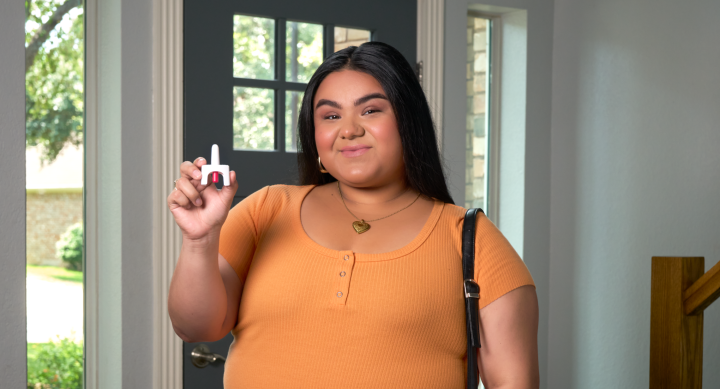Texas Targeted Opioid Response
A health communication initiative to prevent opioid misuse and overdose

Overview
The 86th Texas Legislature tasked the Texas Health and Human Services Commission (HHSC) with producing a statewide health communication campaign intended to prevent opioid misuse and overdose (HB 3285) and demonstrate the state's response to the opioid crisis as part of the Texas Targeted Opioid Response (TTOR) initiative.
The Center for Health Communication supports HHSC in an ongoing partnership that includes creating, implementing, and evaluating the campaign in English and Spanish.
According to the Texas Department of State Health Services, 883 Texans died from fentanyl-related overdoses in 2020. That number climbed to 1,672 deaths in 2021 — an 89% increase.
A series of surveys conducted by the CHC indicate that 1 in 4 Texans has experienced an opioid overdose or knows someone who has.
Expertise
- Quantitative research
- Qualitative research
- Creative strategy
- Campaign branding
- Graphic design
- Creative testing
- Campaign evaluation
- Video concepting and creation
- Website design and maintenance
Timeline

YEAR 1 (2019-2020)
- Conduct formative research to inform the creation of campaign messages and materials, including a competitive analysis of other opioid-related campaigns and a survey of 1,250 Texans
- Develop and test an animated series of video public service announcements (PSA) in a survey of 1,243 Texans
- Create a website to provide information about TTOR and serve as a resource for Texans seeking support for opioid use disorder (OUD)
- Develop a statewide marketing and evaluation plan

YEAR 2 (2020-2021)
- Conduct a survey of 1,484 Texans to assess awareness of and attitudes toward the campaign
- Develop and test a new video PSA aimed at equipping families and caregivers with communication strategies to support loved ones experiencing OUD

YEAR 3 (2021-2022)
- Create a new video PSA aimed at preventing non-medical opioid use among young adults
- Update the campaign and statewide video based on 2021 evaluation results
- Develop and distribute a toolkit to assist Texas communication leaders in educating Texans about opioid misuse, overdose prevention, and risk reduction behaviors
- Conduct a user experience study of the campaign website and use results to make updates to meet the needs of Texans seeking information and treatment for OUD

YEAR 4 (2022-2023)
- Update the campaign to address the rising fentanyl overdose crisis in Texas, including a new video PSA and web content featuring accurate information about fentanyl and how to save a life with naloxone
- Conduct a follow-up website study and a second statewide campaign evaluation
- Conduct a survey of 1,330 Texans to evaluate awareness of and attitudes toward the TTOR campaign

YEAR 5 (2023-2024)
- Develop "Everyday Texas Heros" video aimed at encouraging Texans to carry naloxone and demonstrate its use for reversing an opioid overdose
- Update the Community Leader Toolkit to include timely information about fentanyl and naloxone and develop new one-pagers covering naloxone, opioids, fentanyl, xylazine, and the TTOR initiative
- Conduct a survey of 1,204 Texans to assess awareness of and attitudes toward the TTOR campaign
- Conduct a survey of 304 Texans to explore the association between opioid awareness campaign recall and self-reported measures of stigma

Approach
Evidence-based health communication involves more than simply educating Texans about healthy behaviors. The TTOR campaign employs a multi-level approach to communication that addresses a broad range of factors influencing opioid-misuse, addiction, and overdose.
- Individual - Content promoting attitudes, beliefs, and behaviors that prevent opioid misuse, addiction, and overdose
- Interpersonal - Content aimed at empowering Texans with evidence-based strategies to navigate challenging conversations with loved ones experiencing OUD, including a "Say this/not that" guide to non-stigmatizing language
- Community - Toolkit including credible health education materials for distribution by Texas community leaders
- Statewide - Media campaign, videos, website, and OUD resources tailored to diverse Texan audiences
Materials

Impact
$2.6M
HHSC campaign funding (2019-2024)
32%
of surveyed Texans recalled viewing campaign in the market
309,144
website users (2021-2024)
74%
of surveyed Texans took action after viewing campaign
25,245,015
video views (2019-2024)
Publications

Talking About Prescription Opioid Misuse
Kemp, D., Mackert, M., Li, S., Table, B., Yang, J., Kirtz, S., & Hughes Wagner, J. (2022). Talking About Prescription Opioid Misuse: The Effect of Family Communication Patters and Messages Advocating Direct and Indirect Communication. Health Communication. 39(1), 83-95. https://doi.org/10.1080/10410236.2022.2159136
Related Work

Texas Prescription Monitoring Program
Mitigating opioid risks through effective use of a statewide electronic database that collects and monitors data about controlled substances dispensed in Texas.

Substance User Self-Screener
An interactive self-screening tool to promote social connection and healthy ways to manage stress, with the goal of preventing substance use disorder among Texans.

Eliminate Tobacco Use Initiative (ETU)
Addressing tobacco use across college and universities and more effectively contributing to actions that create a tobacco-free culture.

